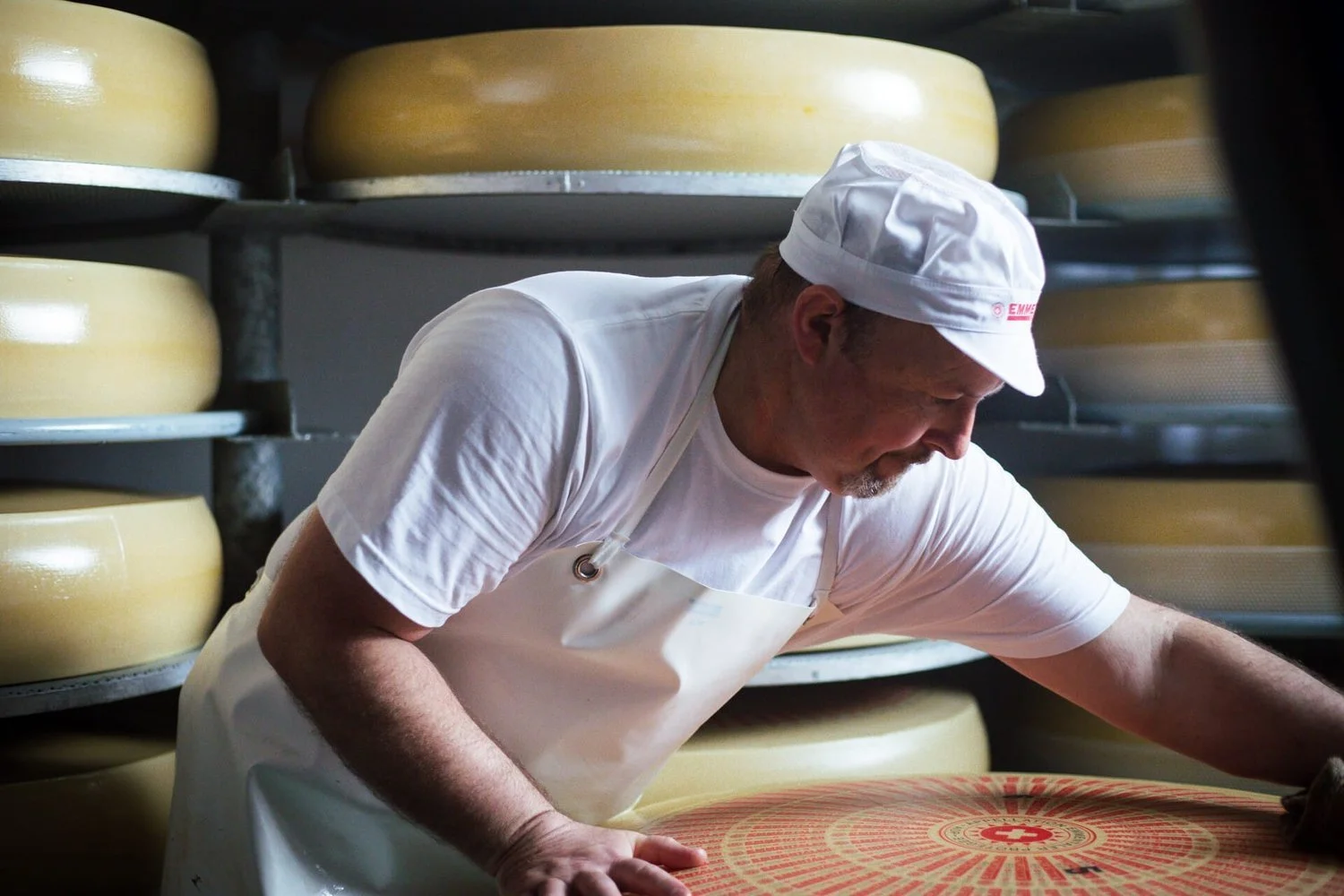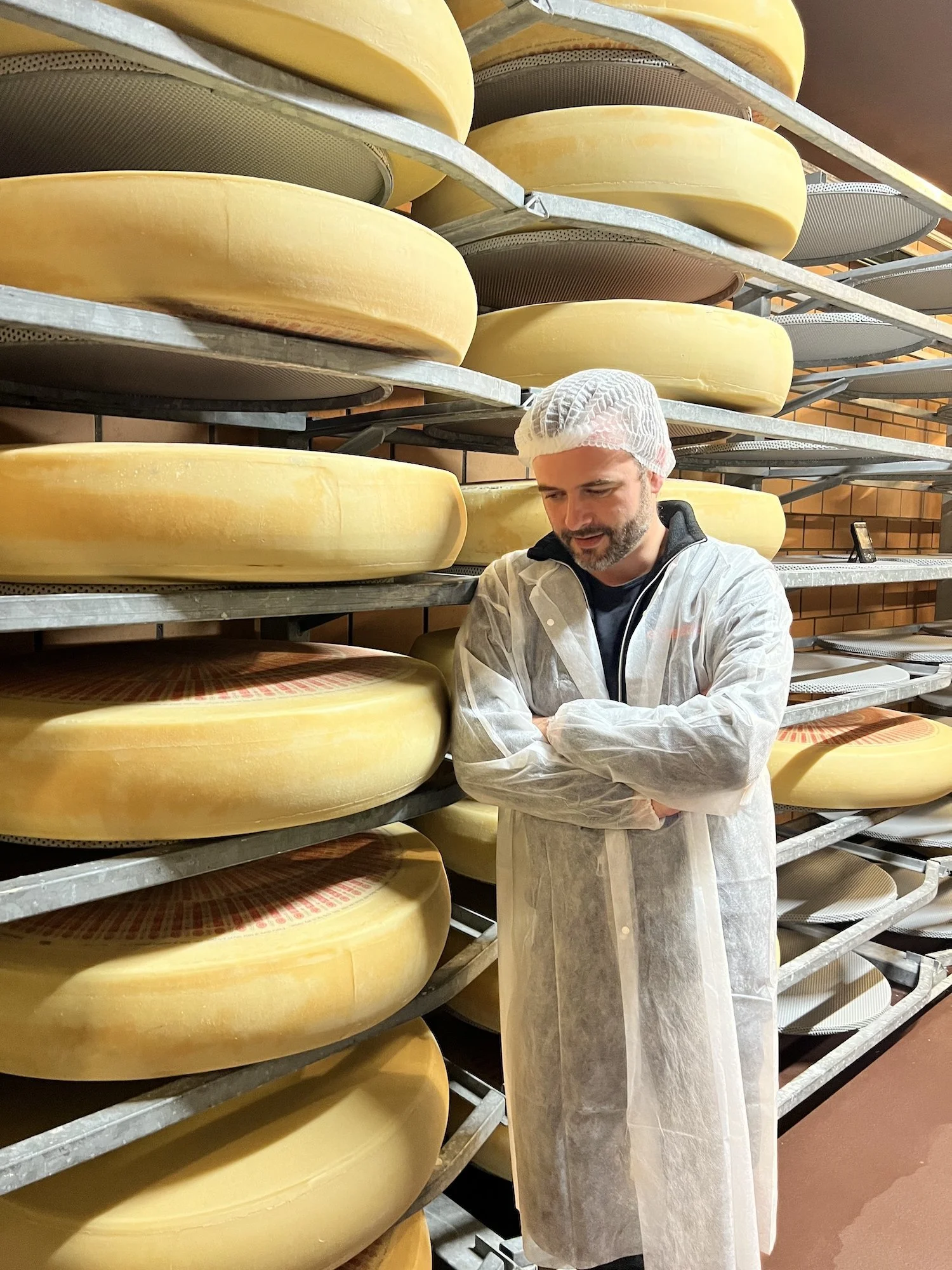Why Emmentaler AOP is the most Iconic of all Swiss Cheeses.
Considered to be the king of all Swiss cheeses, Emmentaler (or Emmental as it is known in the US) dates back to the 13th century and is one of the top cheeses of Switzerland. Colossal in size and mellow in flavor, this medium-hard cheese is best recognized for the large holes in the paste that form during maturation. These ‘eyes’ are not only a hallmark for this classic cheese but have come to represent ‘Swiss cheese’ in general to many consumers.
HISTORY OF EMMENTAL
The earliest evidence of Emmental production dates back to the 13th century, when written records from 1293 mention cheese produced in the Bern canton. The current name “Emmentaler” wasn’t used until nearly 300 years later, when it first appeared in 1542. The name comes from the Germanic name for the Emme Valley - “tal” means valley in German.
After World War II, the Swiss government offered funding to the producers of Tilsiter, Sbrinz, and Emmentaler cheeses to increase production and distribution of their products to support the needs of the population and to maintain Swiss exporting. The dairies of the Emmental responded with over 50,000 tons of cheese the next year. In 1999, production was reduced to the current level of approximately 17,500 tons each year.
Today, Emmentaler is produced in 103 village creameries throughout the regions permitted to produce the cheese, including Aargau, Luzern, Thurgau, and others. There are a total of 11 cantons allowed to make Emmentaler AOP cheese.
THE EMMENTAL REGION
Primarily located in the canton of Bern, this west-central region is a hilly landscape highlighted by the two rivers, Emme and Iilfis. Dairy is the primary industry here, and accounts for the vast majority of the land use. Pottery is also important here, with some artists dating as far back as the 17th century.
The Emmentaler is not considered an alpine region for dairy production, however. While the highest mountain in the area, the Brienzer Rothorn, reaches 7,710 feet, Emmentaler dairy production takes place at altitudes lower than those considered alpine.
EMMENTAL CHEESE
Wheels of Emmentaler AOP are gigantic, measuring over three feet in diameter and weighing in excess of 200 pounds, giving them the nickname “king of all cheeses”. Legend suggests the huge wheel size came from the 19th century practice of taxing cheese by wheel, not weight. Making larger wheels meant paying less in taxes.
Emmentaler AOP is made from four ingredients - raw cow milk, salt, rennet, and natural bacterial starter cultures. No artificial additives or preservatives are permitted to be used. It takes approximately 317 gallons of milk to create a single, 200-pound wheel of Emmentaler. As regional dairy expert Mimo Caci notes, “Only eight to ten percent of what goes in the pot comes out as cheese. After all, cheese is nothing but preserved milk.”
COLLECTING THE MILK
Dairy cows are only milked for two years but are usually kept past that time period for giving milk because they help maintain the social aspects of the herd. “Cows like familiarity and predictability,” Caci says.
The animals are milked mechanically. While that may seem at odds with the romantic idea of hand-milking the animals each morning, using automated milking machines is far better for the well-being of the animal. Caci comments, “The cows are more comfortable and stay healthier when we let the machine do the milking.”
Interestingly, using these machines doesn’t violate any AOP requirements. The reason? The Swiss didn’t establish Emmentaler’s AOP status until 2000, well after the beginning of automation. The practice was simply made part of the recognized process.
Cows are typically milked around 5 am each morning. While that may seem unnecessarily early to some, it’s actually healthier for the animals. Holding in milk produced overnight for too long can injure the cow. The morning milking usually yields almost four gallons of milk per animal. The milking machine records the yield electronically, assigning it to the numbered, microchipped tag on each animal’s ear.
This digital system not only stores the animal’s yields each milking, it also stores any health data on the animal such as illnesses, medications, and dietary needs. While each animal has a unique numerical identifier, they all have names and are known by them. With monikers like Carmen, Wallis, and Danzig, dairy families clearly have a warm relationship with their animals.
It takes roughly an hour to milk the 18 cows on the farm where Caci works. Once each animal is milked, an automated gating system leads to the feeding troughs where a mix of hay and grains is served for breakfast. Depending on the amount of milk produced, each cow may also received a measured amount of high-protein and high-fat feed as allowed by AOP guidelines. The amount of this feed may not exceed 10% of all the calories consumed, however, as it’s meant only to augment the cow’s diet if needed.
To maintain quality and freshness, collected milk must be brought to one of the 100 local dairies within a few hours for processing. The farm itself cannot be more than 12 miles from the dairy making the cheese. Strict testing of each canister of milk transported ensures no bacterial spoilage has occurred, protecting the larger tanks where milks are mixed from contamination.
MAKING EMMENTAL
Milk collected in the evening is skimmed and stored overnight, then blended with the full-fat milk of the next morning’s collection. The blended milk is then heated in 132 gallon, all-copper vats, and the cheesemaking process begins. A special chemical, known as “HKN”, is added to each batch to act as a sort of secret identifier. If a wheel of Emmentaler is suspected to be counterfeit, a quick test for HKN will reveal the truth. “It’s a way of protecting our cheese from being stolen,” Caci proudly asserts.
Once the curds are formed, they are mechanically drained into molds and the wheels are formed. The wheels are then pressed for 12 hours, expelling whey and becoming more firm. At this stage, the famous red and white label is applied, as well as the numerical indicators of the particular farm that provided the milk.
After pressing, the wheels are submerged in brine for 48 hours, an unusually long time, but needed for such a large wheel. This soaking helps draw humidity from the curds. Rind formation and maturation begins as the wheels are stored in a series of rooms for seven days, each with a different humidity and temperature level to help the cheese develop.
At this stage, the wheels are still flat. Emmentaler AOP’s classic bowing comes as the lactic acid bacteria consumes proteins in the curds. The gassing cannot escape the density of the cheese, instead causing the rind to curve outward slightly from the pressure. A month later, the wheels are moved to a maturation cellar, where cooler temperatures cause the bacteria to stop functioning.
AGING EMMENTAL
Emmentaler is offered in several different ages. The youngest wheels are aged for a minimum of four months and have mild, sweet flavors of caramel and dried grass. Classic reserve wheels are typically aged between eight and 12 months and have more aromatic intensity with flavors of hay and dried herbs. The most-aged wheels can reach 36 months, and have savory flavors of earth and spice. There are 8 different types of Emmentaler AOP.
HOW TO USE EMMENTAL
While many American recipes use Emmental in fondue, it’s not typically how the Swiss use the cheese. Emmentaler’s mild flavor and rich texture make it a delicious cheese for all sorts of recipes. Try melting slices for a croque monsieur sandwich, or shredding it into hot pasta with freshly ground black pepper for an alpine version of cacio e pepe. A favorite Emme Valley preparation is to cut aged Emmentaler into cubes, add slices of the locally-made beef sausage cervelat, and mix it with mayonnaise, fresh lemon juice, and chopped herbs.
WHAT CAUSES HOLES IN SWISS CHEESE?
Emmentaler AOP is famous for its cherry-sized holes throughout the interior. In the past, these holes were thought to have formed because of unfiltered, microscopic hay particles found in the milk, and therefore the curds. With a shrug, Cicio emphatically denies this. These spheres of gas are actually caused by propionic acid bacteria consumes the proteins in the curd as the wheel ages. The carbon dioxide gas created by this consumption can’t escape the density of the cheese, and so it becomes trapped. “Hay particles?”, he laughs. “Ridiculous.”





